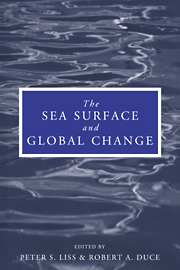Book contents
- Frontmatter
- Contents
- List of contributors
- Preface
- 1 Report Group 1 – Physical processes in the microlayer and the air–sea exchange of trace gases
- 2 Report Group 2 – Biological effects of chemical and radiative change in the sea surface
- 3 Report Group 3 – Photochemistry in the sea-surface microlayer
- 4 Transport processes in the sea-surface microlayer
- 5 The role of organic films in air–sea gas exchange
- 6 Bubbles and their role in gas exchange
- 7 The physical chemistry of air–sea gas exchange
- 8 The sea-surface microlayer and its effect on global air–sea gas transfer
- 9 Chemistry of the sea-surface microlayer
- 10 Biophysics of the surface film of aquatic ecosystems
- 11 Biological effects of chemicals in the sea-surface microlayer
- 12 Neuston of seas and oceans
- 13 Photochemistry in the sea-surface microlayer
- 14 Hydrocarbon breakdown in the sea-surface microlayer
- 15 Applications of laser technology and laser spectroscopy in studies of the ocean microlayer
- 16 Remote sensing of the sea-surface microlayer
- Index
8 - The sea-surface microlayer and its effect on global air–sea gas transfer
Published online by Cambridge University Press: 24 September 2009
- Frontmatter
- Contents
- List of contributors
- Preface
- 1 Report Group 1 – Physical processes in the microlayer and the air–sea exchange of trace gases
- 2 Report Group 2 – Biological effects of chemical and radiative change in the sea surface
- 3 Report Group 3 – Photochemistry in the sea-surface microlayer
- 4 Transport processes in the sea-surface microlayer
- 5 The role of organic films in air–sea gas exchange
- 6 Bubbles and their role in gas exchange
- 7 The physical chemistry of air–sea gas exchange
- 8 The sea-surface microlayer and its effect on global air–sea gas transfer
- 9 Chemistry of the sea-surface microlayer
- 10 Biophysics of the surface film of aquatic ecosystems
- 11 Biological effects of chemicals in the sea-surface microlayer
- 12 Neuston of seas and oceans
- 13 Photochemistry in the sea-surface microlayer
- 14 Hydrocarbon breakdown in the sea-surface microlayer
- 15 Applications of laser technology and laser spectroscopy in studies of the ocean microlayer
- 16 Remote sensing of the sea-surface microlayer
- Index
Summary
Abstract
Laboratory measurements of air–water gas transfer rates for cleaned and film-covered water surfaces have shown that the presence of soluble and insoluble surfactants can inhibit air–water gas fluxes. Naturally occurring surface-active material is known to concentrate in the marine surface microlayer and form films and slicks. It is reasonable that oceanic slicks and films may lower in situ gas transfer rates compared with air–sea gas exchange through a clean ocean surface. Here, a simple model of gas transfer through clean and surfactant-influenced water surfaces is used to develop parameterizations of liquid-phase, and gas-phase, rate-controlled gas transfer velocities through clean and surfactant-influenced ocean surfaces. The parameterization for liquid-phase, rate-controlled processes is used to estimate the effect of naturally occurring surface films on the net global flux of carbon dioxide. The gas-phase, rate-controlled relations are used to study the impact of films on the flux of ammonia from the central Pacific Ocean.
By relating the fractional area coverage of surfactant-influenced sea surface to a global map of net synthetic primary production, the model shows that surface films can increase or decrease the net global oceanic carbon dioxide flux, depending on the regional film coverage.
Introduction
Motivation and purpose
There is little doubt that under laboratory conditions both soluble and insoluble surfactants suppress gas–liquid mass transfer rates.
- Type
- Chapter
- Information
- The Sea Surface and Global Change , pp. 251 - 286Publisher: Cambridge University PressPrint publication year: 1997
- 26
- Cited by



